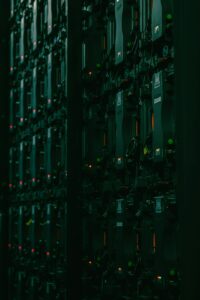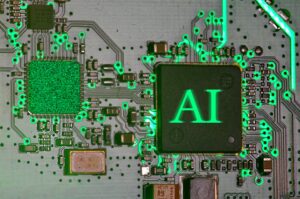Considering the Influence of Artificial Intelligence on the Design of Computer Hardware

Considering the Influence of Artificial Intelligence on the Design of Computer Hardware
Not only is Artificial Intelligence (AI) revolutionizing sectors, but it is also redefining the technology that is responsible for powering our digital world. Conventional computing architectures are undergoing a makeover in order to accommodate the enormous requirements of machine learning, neural networks, and real-time analytics. This is happening as artificial intelligence applications grow more complicated and data-intensive. The next wave of computer hardware innovation is being driven by artificial intelligence, which has become a driving factor behind everything from specialized chips to adaptable CPUs.
1. How Artificial Intelligence Is Changing the Needs for Hardware
The traditional hardware was developed for general-purpose computing, which included the management of spreadsheets, operating systems, and programs that are typically used. Workloads associated with artificial intelligence, on the other hand, need for enormous parallel processing power, quick data flow, and architectures that are energy-efficient and capable of handling billions of operations per second.
In response to this transition, engineers have been compelled to reevaluate the organizational structure of processors, memory, and storage. This means that current technology must now strike a balance between data throughput, model training efficiency, and energy consumption. Previously, it was just necessary to optimize for speed.
2. The shifting core of computing comes from central processing units to accelerators
The central processing unit, sometimes known as the CPU, was the most important component of computers for many years. CPUs, on the other hand, are not the best choice for AI workloads since they carry out operations in a sequential fashion. Computing in artificial intelligence, particularly deep learning, requires the simultaneous processing of massive data sets.
Accelerators such as graphics processing units (GPUs), tensor processing units (TPUs), and neural processing units (NPUs) came into existence as a result of this. These specialized processors are capable of performing parallel operations at remarkable rates, which enables artificial intelligence models to undergo fast training and inference.
3. GPUs: The Engine That Drives Modern Artificial Intelligence
Since their inception, graphics processing units (GPUs) have proven indispensable for the development of artificial intelligence. Their design allows for hundreds of cores, each of which is capable of doing several computations at the same time. This makes them exceptional for matrix and tensor operations, which are used in deep learning.
GPU hardware has been continually refined by manufacturers like as NVIDIA, AMD, and Intel in order to speed up machine learning activities. These manufacturers have introduced novel technologies such as tensor cores, mixed-precision computation, and high-bandwidth memory in order to achieve the highest possible level of performance.
4. TPUs and NPUs have emerged as a result of this.
Custom silicon that is optimized for machine learning has been created by corporations in order to fulfill the special requirements of artificial intelligence workloads.
Developed by Google, tensor processing units (TPUs) are processors that speed up tensor operations that are utilized in neural network calculations. They perform much better than typical graphics processing units (GPUs) in some artificial intelligence workloads.
Neurological Processing Units, or NPUs, are: NPUs are able to perform local artificial intelligence operations such as speech recognition, picture enhancement, and real-time translation while using a minimum amount of power. These NPUs are integrated into laptops and smartphones.
These purpose-built processors represent a move toward the creation of technology that is specifically tailored to artificial intelligence, wherein energy economy and speed are prioritized above general-purpose adaptability.
5. AI-Driven Hardware Design Automation.
Machine learning is not just impacting hardware; it is also developing it. Engineers are now able to use artificial intelligence to build better chip layouts, increase transistor performance, and forecast thermal or power difficulties before producing them. These enhancements are accomplished via the use of methods such as machine learning-based optimization and neural architecture search.
Utilizing artificial intelligence algorithms, companies like as Synopsys, Cadence, and Google are automating chip design in order to reduce the amount of time required for development and improve accuracy. Tools powered by artificial intelligence are able to test billions of design alternatives in a fraction of the time that would be required by human engineers.
6. Memory Architecture: Adapting to the Requirements of Data-Intensive Artificial Intelligence
Artificial intelligence models need enormous datasets for training and inference, which places a significant amount of strain on memory systems. For the purpose of keeping up, hardware designers are adopting:
- High Bandwidth Memory (HBM) is a function that boosts the speed at which data may be transferred between the CPU and the memory.
- Memory designs that take use of three-dimensional stacking allow for increased capacity and closeness between memory and computation units.
- PIM stands for “processing in memory,” which is a technology that integrates computing directly into memory chips, hence decreasing the need to transport data back and forth.
- Latency and power consumption, two crucial bottlenecks in artificial intelligence performance, have been greatly reduced as a result of these developments.
7. Thermal Management and Ecologically Sound Energy Efficiency
Extremely high quantities of power are used by AI tasks. Managing heat dissipation and energy efficiency becomes more important as the complexity of artificial intelligence technology increases. In today’s modern CPUs, dynamic voltage scaling, intelligent cooling, and power-aware scheduling are all features that are driven by artificial intelligence itself.
Energy optimization systems that are powered by artificial intelligence assess workloads in real time to strike a balance between performance and efficiency. This enables servers and data centers to reduce their effect on the environment while keeping their speed.
8. Storage Solutions that are Optimized for Artificial Intelligence
Conventional storage systems have difficulty meeting the continuous read and write requirements of artificial intelligence workloads. Additionally, in order to solve this issue, developers are developing AI-optimized storage structures that include characteristics such as:
- Super-fast data access is made possible via NVMe, which stands for non-volatile memory express.
- By using tiered storage models, data that is often requested may be automatically moved to storage tiers that are quicker.
- As a result of AI-driven caching, bottlenecks during training and inference are reduced. This is accomplished by predicting which data will be required next and preloading it.
- Because of these advancements, it is now feasible to provide huge neural networks with the data they need at the rate that they demand.
9. The Functions Comprised of FPGAs and ASICs in Artificial Intelligence Computing
Field-programmable gate arrays, also known as FPGAs, and application-specific integrated circuits, often known as ASICs, are two developing hardware options for artificial intelligence applications that are more specialized.
- FPGAs are capable of being reprogrammed for certain algorithms, which provides flexibility for the development of AI models.
- To achieve improved efficiency and performance for activities like as face recognition or autonomous driving, application-specific integrated circuits (ASICs) are designed specifically for a particular application.
- Apple, Tesla, and Amazon are just some of the companies that are already using these processors to power their artificial intelligence-driven services and gadgets.
10. Data Centers: The Foundation of Artificial Intelligence Infrastructure
Powerful data centers that are outfitted with GPU clusters, AI accelerators, and liquid cooling systems are essential for the execution of modern artificial intelligence workloads. The processing of enormous volumes of data at these facilities makes it possible to conduct AI training and analytics on a massive scale.
Hardware designers are now concentrating their efforts on modular architectures, rack-level cooling, and workloads handled by artificial intelligence in order to improve the performance and sustainability of data centers. Parallel to the expansion of artificial intelligence capabilities around the globe is the advancement of data center technology.
11. AI at the Edge: Hardware Beyond the Cloud is the eleventh item.
Edge AI hardware is gaining pace as artificial intelligence moves outside the confines of centralized data centers. Processors that are both compact and powerful are utilized in devices such as autonomous drones, industrial robots, and Internet of Things systems. These processors are able to perform on-device inference without relying on cloud connectivity.
By virtue of their low power consumption, rapid reaction times, and offline capabilities, edge artificial intelligence chips are well suited for settings in which the ability to make decisions in real time is of the utmost importance.
12. Artificial Intelligence and Neuromorphic Computing
Computing that resembles the neuronal structure of the human brain is known as neuromorphic computing, and it is one of the most interesting areas in artificial intelligence hardware design. Rather of using binary logic gates, neuromorphic circuits make use of spiking neurons that interact in an asynchronous manner. This brings about significant improvements in both speed and energy economy.
Intel’s Loihi and IBM’s TrueNorth are two examples of projects that are opening the way for processors that can “learn” from data rather than just processing it. This capability has the potential to revolutionize the way artificial intelligence hardware functions.
13. The Next Hardware Revolution in Artificial Intelligence: Quantum Computing
Despite the fact that it is still in its infancy, quantum computing has great potential for tackling issues that are physically impossible for traditional systems to solve. It is possible for quantum computers to process enormous data sets and carry out parallel calculations at rates that have never been seen before.
Researchers in artificial intelligence envision hybrid systems in which quantum computers provide assistance in the training of deep learning models, optimization, and encryption, thereby transcending the capabilities of the hardware that is currently available.
14. Considerations Regarding Ethical and Environmental Issues
The competition to develop quicker artificial intelligence technology poses important problems regarding the use of resources and sustainability. AI training uses a significant amount of both energy and materials, which has led to requests for more environmentally friendly design techniques.
Developers of hardware are now investigating carbon-neutral data centers, recyclable materials, and artificial intelligence-driven energy optimization in an effort to lessen their influence on the environment while still preserving technological advancement.
15. The Beginning of Intelligence in Hardware
Not only has artificial intelligence altered the way in which we utilize computers, but it has also rethought the construction of these machines. AI is driving a revolution in the design of hardware that is focused on speed, flexibility, and efficiency. This revolution is being driven by GPUs and NPUs, as well as neuromorphic and quantum devices.
As artificial intelligence (AI) systems continue to advance, the technology that enables them will also continue to advance. The computers of the future generation will not only be able to handle data; rather, they will be able to think, learn, and optimize themselves in ways that will blur the boundary between machine intelligence and human intellect. A new age in computing has begun, one that is characterized by creativity, autonomy, and boundless possibility. This new era is marked by the combination of artificial intelligence and hardware design.





